沪教牛津版七年级下册教案
牛津沪教版七年级下册同步教案Unit7 In the future-基础部分
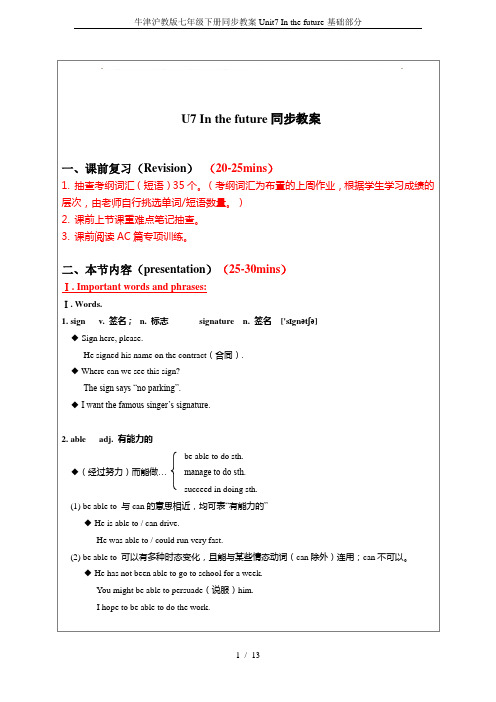
◆ We have three meals a day.
My father likes to use toothpick after meals.
辨析meals,breakfast,lunch,supper
◆表示一日三餐的名词包括breakfast, lunch, supper,原则上说它们是不可数的。
10. make a time box做一个时间盒
11. write down one’s hopes写下某人的愿望
12. seal sth.withtape用胶布密封某物
13. becomeanastronaut成为一名宇航员
. Important Sentences structures.
1.一般将来时
◆经营,管理He kept a hotel in this city.
◆保守(秘密),记(日记)Some of them keep diaries.
◆使...处于某种状态He kept me waiting for half an hour.
(2)作不及物动词时:
◆保持,继续(处于某种状态)
Please keep quiet. He always kept silent at meeting.
Ihope thatI will be a teacher in the future.(动词+ that从句)
Ihope to seeyou and your family soon.(动词+不定式)
7. seal v.密封
◆ The envelope(信封)was firmly sealed.
seal n.海豹
After a quick breakfast, he hurried to the station.
全新牛津上海版七年级英语下册全英文教案(全册 全英文 共47页)
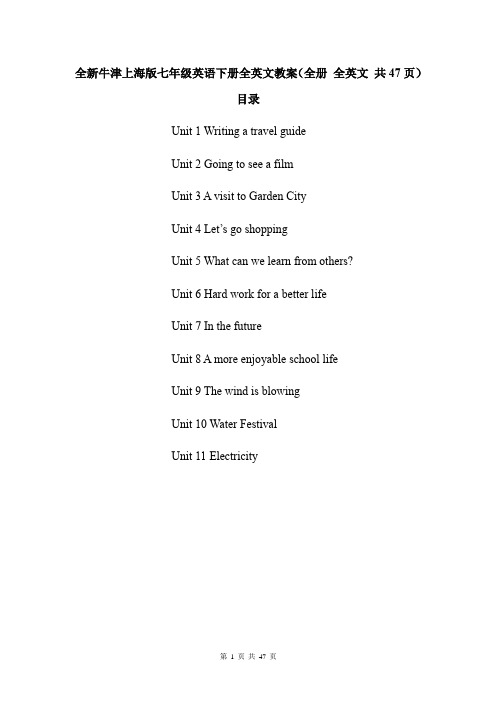
全新牛津上海版七年级英语下册全英文教案(全册全英文共47页)目录Unit 1 Writing a travel guideUnit 2 Going to see a filmUnit 3 A visit to Garden CityUnit 4 Let’s go shoppingUnit 5 What can we learn from others?Unit 6 Hard work for a better lifeUnit 7 In the futureUnit 8 A more enjoyable school lifeUnit 9 The wind is blowingUnit 10 Water FestivalUnit 11 ElectricityUnit 1 Writing a travel guide1教学目标By the end of the lesson, the Sts will…be able to further practise describing a place and know more about Shanghai.be able to develop their speaking ability of fluency by describing a scenic spot.2学情分析The learners are the students form Class Twelve, Grade Seven of North Jincai Secondary School. They have been learning English for 7 years, so they are of different levels. Quit e a few students are quite excellent. They do well in both speaking and writing. They are very active in class. But some students are at a lower English level. However, sometime s they can speak a little in class. What they need is a language environment. Therefore, g roup work in class is helpful for them to take an active part in the class.3重点难点This is ‘more practice’ part of Module One. The topic is A One-day Tour Plan. We have talked about some famous places in the previous period, so the students have learned so me expressions. There will be a language environment created for them so as to encourag e more of them to talk about scenic spots and their tour plans.Key phrases and sentence structures are familiar to students. But it will be a little hard fo r them to organize language with much new information. So teacher can take fully advant age of group work. The students may have difficulty in listening to the French in the sec ond part because of the accent. Teachers can give students a second chance to listen.Some students may also have difficulty in pronouncing some words. Teachers can guide them t o use the dictionaries on their Pads.4教学过程第一学时教学目标By the end of the lesson, the S ts will…be able to further practise describing a place and know more about Shanghai.be able to develop their speaking ability of fluency by describing a scenic spot.学时重点This is ‘more practice’ part of Module One. The topic is A One-day Tour Plan. We have talked about some famous places in the previous period, so the students have learned so me expressions. There will be a language environment created for them so as to encourag e more of them to talk about scenic spots and their tour plans.学时难点Key phrases and sentence structures are familiar to students. But it will be a little hard fo r them to organize language with much new information. So teacher can take fully advant age of group work. The students may have difficulty in listening to the French in the sec ond part because of the accent. Teachers can give students a second chance to listen.Some students may also have difficulty in pronouncing some words. Teachers can guide them t o use the dictionaries on their Pads.教学活动活动1【导入】Lead inIt’s said that th ey really enjoyed the trip to Shanghai. Do you want to know where they have been? I will show you some pictures of places they’ve been. Please take notes when you are watching.T gives the following instructions:1. I will show you some pictures of places they’ve been.2. Please take notes when you are watching.3. After that, please tell me how many places are there altogether and what they are.T shows four pictures of some places.S answers according to the picture.T corrects the mistakes and may show the pictures again if necessary.(Pudong International Airport, the bund, Yu garden, Shanghai zoo, Xintiandi, Shanghai Sci ence and Technology Museum and Shanghai Museum)活动2【活动】Input-listeningT: Among these pictures, do you know their favourite place?Students may give some answers or no answer.T: I’ve invited 4 French students to talk about their favourite places. Let’s listen to them. Please take notes while listening.T plays the recording one by one.T invites students to give answers and give reasons.T gives feedback if the students’ answers are wrong.活动3【活动】Input-readingT: French students told me that they wanted to know more about Shanghai, about those t hey have been to, and also about those they haven’t. Would you please give them some i ntroductions about more places? First, you need to read some instructions.T gives the instructions.1. Work in a group of 6.2. Each group needs to read 8 passages and find useful information as much as possible.3. Take notes and finish the table.4. Group A is responsible for sightseeing, Group B shopping and Group C eating.T provides individual drilling.活动4【活动】Output-an introduction about a scenic spotT invites some students to introduce some scenic spots according to the information they have taken down.T gives feedbacks about their presentations.活动5【活动】Output-a tour planT: I think they will enjoy those places. So why not make a tour plan for them? Please d iscuss with your group members and make a one-day tour plan for them. Each group nee ds to focus on your task. (Group A sightseeing Group B eating Group C shopping.)T provides individual drilling.T invites some students to give presentations about their tour plans.T gives feedbacks about their presentations.活动6【作业】AssignmentT: Write down your 3-day tour plan for French students. The school may use your plan next year.e.g.: On the first day, they are going to …Unit 2 Going to see a film1教学目标认知目标:课标词汇hardly, type, operate, railway, fly, judge, raise, instruction, program, mistake, hold, video, more importantly, have great understanding of…, make mistakes, for the time being拓展词汇unaware, be unaware of…, dependent, be dependent on…,diagram,essential, drive, CD-ROM, DVD-ROM2. 能力发展目标:1)通过多种形式的阅读活动与任务,培养一些阅读微技能,如:整体把握文章大意,快速搜索信息的能力2)设计小组合作,学会交流与合作3)情感目标:拓展学生视野,培养学生正确表达自己观点,学会对电影做出评价2学情分析1.这是一篇影评,比较枯燥,学生容易失去兴趣。
深圳沪教牛津版七年级下册英语Unit 1 教学教案

Unit1单词一览person [ 'pə:sn ] n.人cheerful[ 'tʃiəful ]adj. 快乐的;高兴的hard-working[hɑ:d 'wə:kiŋ] adj. 工作努力的;勤勉的patient [ 'peiʃənt ] adj. 耐心的smart[ smɑ:t ] adj. 聪明的;机敏的probably [ 'prɔbəb(ə)li ] adv. 很可能forget [ fə'get ] v. 忘记smell [ smel ]n. 气味care[ keə(r) ]n. 照顾;照料miss[ mis ] v. 想念;怀念joke[ dʒəuk ] n. 玩笑laugh[ la:f ] v. 笑remain [ ri'mein ] v. 仍然是;保持不变strict[ strikt ] adj. 严格的;严厉的encourage [ in'kʌridʒ ] v. 鼓励support[ sə'pɔ:t ]n. 支持successful [sək'sesfl]adj. 获得成功的member [ 'membə(r) ] 成员paragraph [ 'pærəgra:f ] 段落词汇精讲1.________人__________ adj.个人的personal computer________ 【即学即用】:( ) He is an honest _______ , so what he said is believable.A. childrenB. smellC. jokeD. person2.快乐的高兴的(adj) _____________ = ______________ 【同根词】_______ n & v高兴;使振奋【固定搭配】:cheer up________ *cheerleader___________Cheerleaders’ task(任务) is to cheer up players._________________________________________________ _____●Yellow is a _________________ (cheer) color.●She is a happy girl. She is always __________________(cheerful / sad).【即学即用】:()1. --- He has many friends, so he always looks cheerful.--- Yes, he really is.A. sadB. worriedC. happy()2. Tom is a _______ student. So he does well in his lessons.A. cheerfulB. tallC. hard-workingD. lazy3. (1) __________ adj. 耐心的_______ n. 耐心【固定搭配】:be patient with sb _______________________(2) ________ n.病人The doctor is patient with his patients.Mr Oliver is very_____________ (patience).5. _____ adj.聪明的= ___________比较级: ______________ 最高级______________●At present, everyone is playing smart phone on thesubway.●He likes to ask himself “Am I smarter? ”6.___________ adv.很可能= ___________【同根词】:adj. _________You’re ____________ (probable) right.—“Will it be a sunny day tomorrow?”—“Probably not.”7.________ v.忘记(过去式)________(过去分词)___________【反义词】:___________forget的短语:forget to-v / forget v-ing(1) forget to do sth.表示“______________”(未做)Don’t forget to turn off (关闭)the light when you leave.(2) forget doing sth表示“_______________”(已做)He forgot watering (浇花) the flowers.思考:remember to v 与remember v-ing●remember to do sth.表示________________________________________●remember doing sth.表示_________________________________________【即学即用】:●( )Don’t forget an umbrella you.It’s going to rain.A. to take; toB. taking; toC. to take; withD. take; with●I forgot _______ (close) the door, so I went back to have alook.●Remember ______ home to see your grandparents usually.8.____________ n.气味;v.闻;闻起来①作名词,意为“气味”。
沪教牛津七下《unit 4 writing》 教学设计
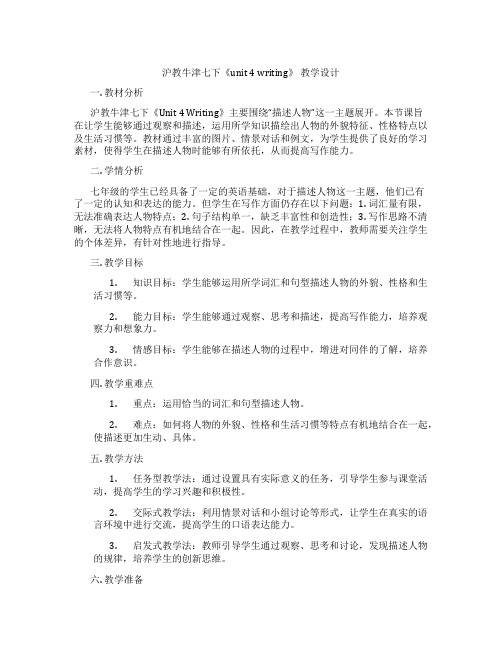
沪教牛津七下《unit 4 writing》教学设计一. 教材分析沪教牛津七下《Unit 4 Writing》主要围绕“描述人物”这一主题展开。
本节课旨在让学生能够通过观察和描述,运用所学知识描绘出人物的外貌特征、性格特点以及生活习惯等。
教材通过丰富的图片、情景对话和例文,为学生提供了良好的学习素材,使得学生在描述人物时能够有所依托,从而提高写作能力。
二. 学情分析七年级的学生已经具备了一定的英语基础,对于描述人物这一主题,他们已有了一定的认知和表达的能力。
但学生在写作方面仍存在以下问题:1. 词汇量有限,无法准确表达人物特点;2. 句子结构单一,缺乏丰富性和创造性;3. 写作思路不清晰,无法将人物特点有机地结合在一起。
因此,在教学过程中,教师需要关注学生的个体差异,有针对性地进行指导。
三. 教学目标1.知识目标:学生能够运用所学词汇和句型描述人物的外貌、性格和生活习惯等。
2.能力目标:学生能够通过观察、思考和描述,提高写作能力,培养观察力和想象力。
3.情感目标:学生能够在描述人物的过程中,增进对同伴的了解,培养合作意识。
四. 教学重难点1.重点:运用恰当的词汇和句型描述人物。
2.难点:如何将人物的外貌、性格和生活习惯等特点有机地结合在一起,使描述更加生动、具体。
五. 教学方法1.任务型教学法:通过设置具有实际意义的任务,引导学生参与课堂活动,提高学生的学习兴趣和积极性。
2.交际式教学法:利用情景对话和小组讨论等形式,让学生在真实的语言环境中进行交流,提高学生的口语表达能力。
3.启发式教学法:教师引导学生通过观察、思考和讨论,发现描述人物的规律,培养学生的创新思维。
六. 教学准备1.准备相关人物的图片、视频等素材。
2.设计好课堂活动和任务。
3.准备写作评价标准。
七. 教学过程1.导入(5分钟)教师展示一组人物图片,让学生观察并猜测这些人物的身份。
通过这个环节,激发学生的兴趣,引出本节课的主题。
2.呈现(10分钟)教师通过展示图片、视频等素材,呈现本节课的主要词汇和句型,为学生描述人物做好铺垫。
牛津上海版七年级英语下册教学设计:Unit7Inthefuture

(二)讲授新知
1.教学活动设计:
-采用讲解、示例、互动问答等形式,帮助学生掌握一般将来时态的用法。
-结合图片和实际情境,引导学生学习本单元的词汇和短语。
2.教学内容:
-讲解一般将来时态的结构,如will、be going to,并通过例句展示其用法。
2.难点:如何引导学生运用一般将来时态进行准确、流畅的口语表达和书面表达;培养学生对未来话题的深入思考和创造性想象。
(二)教学设想
1.创设情境,激发兴趣:通过展示未来科技发展的图片和视频,引发学生对未来世界的思考,激发学习兴趣,为新课的学习做好铺垫。
-利用多媒体资源,呈现太空探索、环保技一)导入新课
1.教学活动设计:
-利用多媒体播放一段关于未来科技发展的短片,引发学生对未来世界的好奇心和兴趣。
-短片结束后,邀请学生分享他们对未来科技的看法和期待,为新课的学习营造积极氛围。
2.教学内容:
-通过提问方式,引导学生回顾已学过的时态知识,为新学习的一般将来时态做好铺垫。
3.任务型教学,促进交流:设计丰富多样的课堂活动,鼓励学生运用目标语言进行互动交流,提高语言实际运用能力。
-小组合作,编写关于未来生活的对话或短文,培养学生的合作精神和口语表达能力。
-角色扮演,模拟未来场景,让学生在实际情境中运用所学知识,提高语言运用能力。
4.拓展思维,培养创造能力:引导学生关注未来科技、环保等社会问题,激发他们的思考和创新意识。
-编写一段关于未来生活的短文,至少包含5个本单元所学词汇,要求语言表达准确、流畅。
2.口语作业:
-与同学合作,进行一次关于未来科技或环保话题的角色扮演对话,记录下来,并尝试使用一般将来时态进行表达。
牛津沪教版英语七年级下Unit1 新课教案

We’ll go on an outing if it doesn’t rain tomorrow.
If you go there, you can find a famous church.
24.世纪公园Century Park
25.上海科技馆Shanghai Science and Technology Museum
26.卢浦大桥Lupu Bridge
27.外滩the Bund
28.在崇明岛上on Chongming Island
29.以……闻名be famous for
30.被誉为be known as
5.看喷泉和鸽子see fountains and pigeons
6.吃不同的地方小吃eat different local snacks
7.去南京路go to Nanjing Road
8.在大型百货公司购物buy things in large department stores
9.去过某地(已返回)have been to …
It is + adj. + to do sth.表示“做……太……了”
It is convenient to travel between Pudong and Puxi.
=To travel between Pudong and Puxi is convenient.
It is terrible to have dinner in this restaurant. The food tastes awful.
41.做某事是很方便的It is convenient to do….
牛津沪教版英语七年级下Unit 3 Lesson 1辅导教案
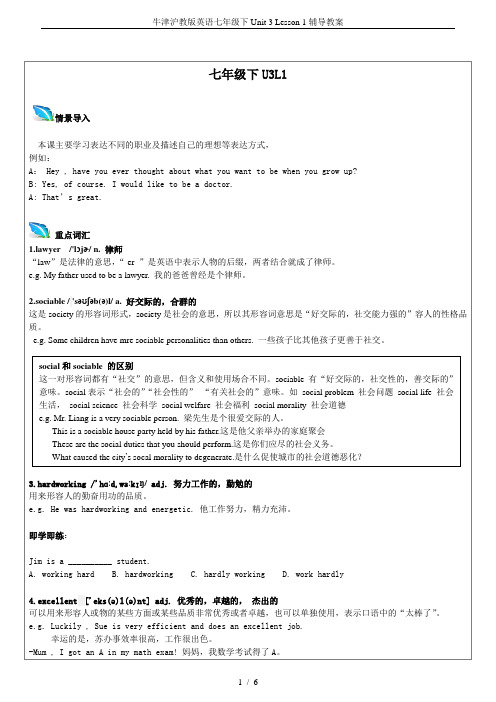
七年级下U3L1情景导入本课主要学习表达不同的职业及描述自己的理想等表达方式,例如:A: Hey , have you ever thought about what you want to be when you grow up?B: Yes, of course. I would like to be a doctor.A: That’s great.重点词汇wyer /'lɔjɚ/ n. 律师“law”是法律的意思,“-er ”是英语中表示人物的后缀,两者结合就成了律师。
e.g. My father used to be a lawyer. 我的爸爸曾经是个律师。
2.sociable /'səʊʃəb(ə)l/ a. 好交际的,合群的这是society的形容词形式,society是社会的意思,所以其形容词意思是“好交际的,社交能力强的”容人的性格品质。
e.g. Some children have mre sociable personalities than others. 一些孩子比其他孩子更善于社交。
social和sociable 的区别这一对形容词都有“社交”的意思,但含义和使用场合不同。
sociable 有“好交际的,社交性的,善交际的”意味。
social表示“社会的”“社会性的”“有关社会的”意味。
如social problem 社会问题social life 社会生活,social science 社会科学social welfare 社会福利social morality 社会道德e.g. Mr. Liang is a very sociable person. 梁先生是个很爱交际的人。
This is a sociable house party held by his father.这是他父亲举办的家庭聚会These are the social duties that you should perform.这是你们应尽的社会义务。
牛津上海版英语七年级下册《Unit 7 In the future》教学设计7

牛津上海版英语七年级下册《Unit 7 In the future》教学设计7一. 教材分析牛津上海版英语七年级下册《Unit 7 In the future》主要讲述了关于未来的话题。
本单元包括一般将来时态的用法、描述未来世界的科技发展、谈论未来的梦想和计划等。
教材通过丰富的文本材料、插图和练习,帮助学生掌握一般将来时态的构成和用法,提高他们的语言表达和思维能力。
二. 学情分析七年级的学生已经掌握了基本的英语语法知识,对于一般现在时态和一般过去时态有一定的了解。
但是,对于一般将来时态的运用还比较陌生,需要通过大量的练习和实际运用来提高。
此外,学生对于描述未来世界的科技发展、谈论未来的梦想和计划等方面的内容比较感兴趣,有利于激发他们的学习兴趣和积极性。
三. 教学目标1.知识目标:–掌握一般将来时态的构成和用法;–能够用英语描述未来世界的科技发展、谈论未来的梦想和计划。
2.能力目标:–能够正确运用一般将来时态进行语言表达;–提高学生的思维能力和创新能力。
3.情感目标:–培养学生的学习兴趣和积极性;–培养学生的团队合作意识和交流能力。
四. 教学重难点1.教学重点:–一般将来时态的构成和用法;–描述未来世界的科技发展、谈论未来的梦想和计划。
2.教学难点:–一般将来时态的运用和实际语境中的运用;–学生创新思维的培养和团队合作的。
五. 教学方法1.任务型教学法:通过设计各种任务,让学生在实际语境中运用所学知识,提高语言表达和思维能力。
2.合作学习法:学生进行小组讨论、合作完成任务,培养团队合作意识和交流能力。
3.情境教学法:通过创设情境,让学生在具体的情境中感知和运用语言知识。
4.激励评价法:注重对学生的积极评价,激发学生的学习兴趣和自信心。
六. 教学准备1.教学材料:教材、多媒体课件、黑板、教学卡片等。
2.教学工具:投影仪、计算机、音响设备等。
3.教学资源:网络资源、图片、视频等。
七. 教学过程1.导入(5分钟)利用图片或视频展示未来世界的场景,引导学生谈论对未来的想象和期待。
2015-2016学年牛津沪教版初中英语七年级下册精品教案 Unit_4_Save_the_trees
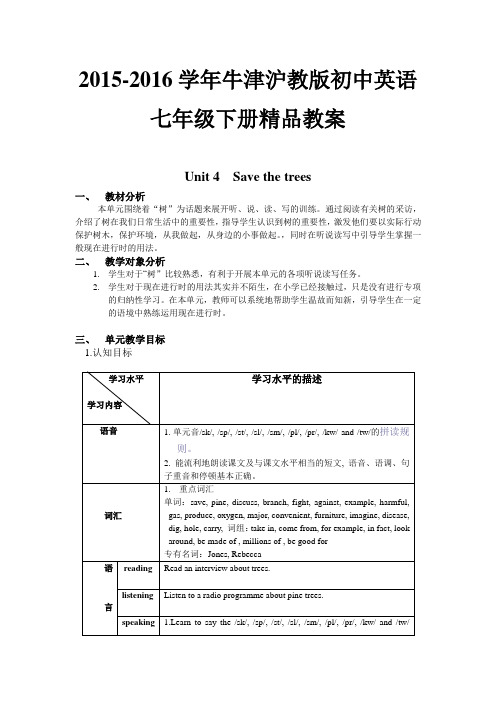
2015-2016学年牛津沪教版初中英语七年级下册精品教案Unit 4 Save the trees一、教材分析本单元围绕着“树”为话题来展开听、说、读、写的训练。
通过阅读有关树的采访,介绍了树在我们日常生活中的重要性,指导学生认识到树的重要性,激发他们要以实际行动保护树木,保护环境,从我做起,从身边的小事做起。
,同时在听说读写中引导学生掌握一般现在进行时的用法。
二、教学对象分析1.学生对于“树”比较熟悉,有利于开展本单元的各项听说读写任务。
2.学生对于现在进行时的用法其实并不陌生,在小学已经接触过,只是没有进行专项的归纳性学习。
在本单元,教师可以系统地帮助学生温故而知新,引导学生在一定的语境中熟练运用现在进行时。
三、单元教学目标1.认知目标21)能够在听、说、读、写等语言综合实践活动中运用本单元的重点词汇、句型与语法。
2)在学习中提高交流和传递信息的能力,在写作中句型使文章更连贯和流畅。
3)通过指导学生在模拟交际中运用所学的知识,培养学生探究学习、合作学习、自主学习的能力。
四、单元教学重点1.学生熟练掌握重点词汇19个,短语8个2.指导学生利用所学句型正确表达思想、进行交际活动。
3.指导学生归纳现在进行时用法并在实践中熟练运用它们。
五、单元教学重点1. 通过形式多样的课堂活动与任务,帮助学生完成阅读理解、听力理解等学习任务。
2. 引导学生积极主动地探究学习,从教材以外的渠道去了解与本单元主题相关的文化背景信息、资料等,并且与同学进行相互交流,顺利开展包括口头汇报、写作展示等拓展活动,培养学生探究学习、自主学习、合作学习的能力。
六、教学策略1.在教学中,教师应积极设情景引入,配合媒体、表情、动作、进行视听说演示,激发学生兴趣。
2.教师应采用有利于学生学习的教学方法,善于引用学生通过阅读或观察、比较对比知识进行归纳总结。
增加学习内容的复现和巩固练习、及时反馈学习情况。
3.教师应该根据自己学生的具体情况对教材进行整合,精讲精练,调动学生的学习兴趣,使他们积极参加参与课堂各种学习活动。
牛津沪教版英语七年级下Unit3Lesson1辅导教案
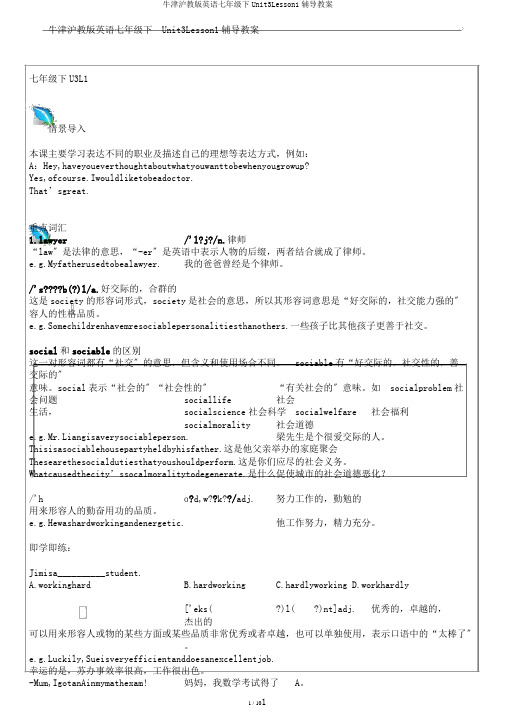
牛津沪教版英语七年级下Unit3Lesson1辅导教案七年级下U3L1情景导入本课主要学习表达不同的职业及描述自己的理想等表达方式,例如:A:Hey,haveyoueverthoughtaboutwhatyouwanttobewhenyougrowup?Yes,ofcourse.Iwouldliketobeadoctor.That’sgreat.重点词汇wyer /'l?j?/n.律师“law〞是法律的意思,“-er〞是英语中表示人物的后缀,两者结合就成了律师。
e.g.Myfatherusedtobealawyer. 我的爸爸曾经是个律师。
/'s????b(?)l/a.好交际的,合群的这是society的形容词形式,society是社会的意思,所以其形容词意思是“好交际的,社交能力强的〞容人的性格品质。
e.g.Somechildrenhavemresociablepersonalitiesthanothers.一些孩子比其他孩子更善于社交。
social和sociable的区别这一对形容词都有“社交〞的意思,但含义和使用场合不同。
sociable有“好交际的,社交性的,善交际的〞意味。
social表示“社会的〞“社会性的〞“有关社会的〞意味。
如socialproblem社会问题sociallife 社会生活,socialscience社会科学socialwelfare 社会福利socialmorality 社会道德e.g.Mr.Liangisaverysociableperson. 梁先生是个很爱交际的人。
Thisisasociablehousepartyheldbyhisfather.这是他父亲举办的家庭聚会Thesearethesocialdutiesthatyoushouldperform.这是你们应尽的社会义务。
Whatcausedthecity’ssocalmoralitytodegenerate.是什么促使城市的社会道德恶化?/'h ɑ?d,w??k??/adj. 努力工作的,勤勉的用来形容人的勤奋用功的品质。
word完整版牛津沪教版英语七年级下Unit1复习教案

牛津沪教版英语七年级下Unit1 复习教案U1 Writing a travel guide教学过程:1.词汇梳2.重要句型及语3.课堂练4.家庭作Part 词汇梳理1. guid nv.(1) guid作名词时,可以表示①导游The guide took us around the Palace Museum.导游带我们参观了故宫②导游手相当guidebookDo you need a guide?It tells you a lot about the Forbidden City.你需要一本导游手吗?它会告诉你很多关于紫禁城的信息③指南A Guide to English Grammar《英语语法指南(2) guid作动词时,可以表…领路,带的意思。
如Martin guided him to the reception room.马丁把他领到接待室批注:让学生注意分guid的两种词2. tour n旅行;旅Can you give us some tour suggestions?你能给我们一些旅行建议吗【联想touristn.游客,旅游3. reason n.原因,理The reason why she was late was that she forgot to set the clock.她迟到的原因是因为忘记了定闹钟【近义词causen.原因,起因,缘故;理【拓展reasonableadj.合理的,明智批注the reason wh的句可以让学生用在写作中3. take part in参加(活动如We'll take part in the sports meeting this Friday.本周五我们要参加运动会They have decided to take part in a competition.他们决定参加一个竞赛【比较take part ijoin都参的意思take part in表示参加某项活动joi示参加或加入某个团体或组织如He joined the Party ten years ago他十年前入党I'll join the Youth League next month.下个月我要入团【提示take part in = join in批注:注take part injoi的区4. sightseeingn观光;游Tourists usually go there for sightseeing and fun游客们通常会去那儿观光游玩【记忆go sightseein去观【联想go shoppin去购物go swimmin去游泳go fishin去钓鱼go travellin去旅游11/ 1复习教案牛津沪教版英语七年级下Unit1去徒步旅行go boating去划船;go hiking go camping去野营;go cycling去骑车;去打猎go windsurfing去风帆冲浪;go hunting go skating去溜冰;观光旅游 a sightseeing tour【拓展】a sightseeing bus观光旅游车的中部位于……5. in the centre ofin the middle of 强调与四周距离相等的中心位置,常用来指空间;【比较】in the centre of强调两端之间的位置,并不强调中心,既可用于指空间,也可用于指时间。
牛津沪教版英语七年级下Unit2 新课教案

15. get to…from…从…到…
16. the way to the cinema到电影院的路
17. turn left/ right…into_______(street/road)向左/右拐进…路/街道
【语言点精讲】
1.I like funny films very much.
牛津沪教版英语七年级下unit2新课教案16七年级下unit一新课讲解词汇拓展do同义词组wouldlikedo想要做某事filmguide阅读电影指南discusswhichfilmsee讨论看哪部电影看一看havefumyfilms滑稽电影actionfilm动作片filmsaboutadventuresclownspolicemenrobbers冒险片小丑片警匪片robber抢劫犯要注意robrobberylovestoryabout?一个关于?的爱情故事fullfun充满笑声和趣事laughv
( ) 8. We’ve got to decide which film _________.
A. has seen B. to see C. seeing D. see
( ) 9. There are quite _________ interesting films on these days.
full of laughter and fun充满笑声和趣事
laugh笑(v.)laughter笑声(n.)
be full of充满full是个形容词,表示满的,饱的
be full of与be filled with是近义词,同时要注意
fill……with……的用法(用。。。装满。。。)
e.g. The room is full of people.这间屋里挤满了人----The room is filled with people.
Unit4第二课时教案-2023-2024学年牛津上海版英语七年级下册

- 自主学习法:引导学生自主思考,培养自主学习能力。
- 信息技术手段:利用在线平台、微信群等,实现预习资源的共享和监控。
- 作用与目的:帮助学生提前了解一般过去时态的用法,为课堂学习做好准备。培养学生的自主学习能力和独立思考能力。
2. 课中强化技能
教师活动:
- 导入新课:通过讲述一个有趣的故事,引出一般过去时态的用法,激发学生的学习兴趣。
核心素养目标分析
本节课旨在培养学生的英语学科核心素养,包括语言能力、文化意识、思维品质和学习能力。
1. 语言能力:通过阅读和讨论,学生能够运用一般过去时态描述过去的事件,提高他们的口语表达能力和写作能力。
2. 文化意识:通过学习故事中Inventor的创新精神,学生能够了解和尊重不同的文化背景,培养跨文化交际的能力。
在教学过程中,我将引导学生通过阅读理解故事内容,学习一般过去时态的构成和用法。通过小组讨论和互动,学生能够运用一般过去时态描述过去发生的事情。在课堂活动中,我将鼓励学生积极参与,提高他们的口语表达能力和团队合作能力。
在教学资源方面,我将使用多媒体教具如PPT和视频,以增加学生对课程的兴趣和参与度。同时,我会设计一些互动游戏和练习,使课堂氛围更加活跃,帮助学生更好地理解和运用所学知识。
3. 随堂测试:设计一份随堂测试,包括选择题、填空题和简答题,以评估学生对一般过去时态的掌握程度。测试内容应涵盖时态的构成、用法和实际运用。
4. 作业完成情况:评估学生完成作业的质量和速度。检查学生是否能正确运用一般过去时态,并在作业中展示出对故事内容的理解。
5. 学生自我评价与反思:要求学生对自己的学习过程和成果进行自我评价和反思。评估学生是否能识别自己的不足,并提出改进建议,以促进自我提升。
2015-2016学年牛津沪教版初中英语七年级下册精品教案 Unit_1_People_around_us

2015-2016学年牛津沪教版初中英语七年级下册精品教案Unit 1 People around us一、教材分析本单元围绕着“人”的话题来展开听、说、读、写的训练。
Reading A以三位学生谈论他们身边熟悉的人,帮助学生了解如何进行描写身边的以及常用句式。
作为初中一年级的学生,规范地向别人描述人是一种必备的能力,也是认识及评价人的一种重要手段。
语法方面讲述定冠词the的用法,并培养学生在描述人中如何正确使用定冠词。
具体课型、课时安排如下:二、教学对象分析1.学生升入中学已有一学期,已经基本适应了初中的学习,通过对人进行描述,让学生学会描述人并对身边的人进行初步评价,有利于开展本单元的听、说、读、写任务。
2.学生在小学阶段就已经接触过了定冠词the的用法,本单元再通过系统地复习,在学习方式上引导学生学习归纳总结。
三、单元教学目标1.认知目标:2. 思想情感目标:1)通过谈论“身边的人”的相关话题,帮助学生如何描述人并对身边的人作出适当的评价。
2)结合课文的内容,引导学生如何对身边的人作出评价作谨慎交友。
3. 能力发展目标:1)能够在听、说、读、写等语言综合实践活动中运用本单元的重点词汇、句型与语法。
2)在学习中提高交流和传递信息的能力,在写作中正确运用连词使文章更连贯和流畅。
3)通过指导学生在模拟交际中运用所学的知识,培养学生探究学习、合作学习、自主学习的能力。
四、单元教学重点1. 学生熟练掌握重点词语,词组及句型。
2.指导学生利用所学句型正确表达思想、进行交际活动。
3.指导学生归纳、总结定冠词the的用法,并在实践运用中熟练运用。
4. 指导学生巩固写人的基本方法。
五、单元教学难点1. 如何进行描述人。
2. 定冠词the的归纳整理及运用。
六、教学策略1. 引导学生积极主动的通过预习完成可以自己学会的部分,课堂学习完成学习的重难点,通过复习及归纳总结完善单元的学习。
2. 在教学中以旧带新,引导学生用正确的句子表达思想。
沪教牛津版初一下册英语全册教案(教学设计)

沪教牛津版七年级下册初中英语全册教案(教学设计)Unit 1 People around us 教案课题:Unit 1 --- People around us (阅读课)课时:第 1 课时,共4课时课型:new words教学目标:1.To know the meaning of the new words and the students can use the words to make sentences.2.To train the students’ ability o f cooperation.教学重点: The pronunciation and the usages of the new words: cheerful , hard-working , patient, person, smart, forget, smell , strict, encourage, remain , support successful, remember.教学难点: The usages of the new words: forget , remember , patient , strict, remain , strict.教学准备: e some pictures and games and PPT .2.a recorder .教学步骤:Step 1 Warming up. Freely talk:who do you like best around you ?show some pictures of teacher,father ,mother,friend, on the PPT to talk about them.Step 2 New words.1.Read the new words after the teacher or the tape.2.Group work to remember the new words3.Help the students when they have trouble in reading the new wordsStep 3 Key words learning.1.Show the PPT of the meaning of the key words for them to finish Part A1.2. Let Ss make more sentences with the new words .Step 4 Have a competitioncheck the words and give them marks for the groupsstep5 ReadingBefore reading : 1.Ask Ss to look at the pictures and the titles of the three articles on page 3.2.Check their answers.While reading : 1.Read the article quickly, and then finish Part D1.2. Check their answers.Post reading: 1.Ask Ss to finish Part C1 and C2.2. Check their answers.Step 6 Reciting the article1.Play the tape for them to listen and repeat.2.Show PPT for them to retell the article.ExercisesTo consulate the usages of the new wordsstep 7 SummaryGive them a piece of paper to write the words.Step 8 Homework1.Dictation2.correct the mistakesStep9 The blackboard designUnit 1 People around us1. be cheerful快乐2.as well 也3.take care of 照顾4.tell jokes 讲笑话5.make sb laugh 使某人发笑6.be good at 擅长于…7.be strict in sth 对某事严格要求be strict with sb对某人严格要求课题:Unit 1 People around us (听说课)课时:第2课时,共 4 课时课型:Listening & Speaking教学目标:1.Learn how to use the new words or phrases to describe a person2. improve their listening and speaking skills教学重点: To catch the missing words when listening教学难点: Learn to take note quickly when listening教学准备: Group work. Self—study教学步骤:Step 1: Prepare for the listening and speakingReview some words and phrases which can be used to describe a person Step 2: Do the listening1.Play the listening materials , stop when necessary2.Check the answersStep3.SpeakingGive a sample dialogue to students and ask them to imitate itStep 4:Make notes about the listening.1.Tell them to find the key words.2.Write down the key words you get in the listening part.Step5 Speaking1.学习双元音/iə/、/eə/、/uə/1)Read after the teacher or the tape.2)Read by themselves.2.Listen to the tape and finish A1 then check their answers.3.Learn A2. Ask Ss to read these sentences. Pay attention to the letters in red.4.Speaking upWork in groups to discuss the people they like .S1: Who do you like?S2: I like …S1: What does/did he/she look like?…Step6:Sum upStep7HomeworkStep8 The blackboard designUnit 1 People around us1.描写人的外貌的词2. 双元音/iə/、/eə/、/uə/课题:Unit 1 People around us(语法及运用课)课时:第3时,共 4 课时课型:Grammar教学目标:1.to grasp the usage of the definite word the and the preposition with2. to raise the students’ ability to sum up some language rules教学重点: Know when should use the in front of a noun and when we should not use it and the usage of the with phrases to describe a person教学难点: When we should not use the in front of a noun.教学准备:PPT, Blackboard教学步骤:Step1:Free talkTalk about the noun with an, a and the .Step2: WritingBefore writing: Give Ss the title of the article to talk about.1.Who are you going to write about?2.Think about the following ideas.1)a family member2)a good friend3)a teacher or a great personWhile writing:1.Write a short article about this person.Show some PPT to help them to write the article.2.介绍一些描述人常用的词汇.3. Ask Ss to re ad “My dad”as an example.Step3:More practiceAsk Ss to re ad the article about Mother’s Day quickly.Then answer the questions.1.When is Mother’s Day?2.What do people like to do this day?3.What do the author advise people to do on this day?Step4 Study skills1.Learn line graphs and bar charts to show the change in numbers.2.Fill in the blanks.3.Check their answers.Step 4:Culture corner1.Introduce middle names for Ss.2.Write some famous people’s middle names.Step5:Sum up1.Go over the rules of theStep6: HomeworkStep7 The blackboard design1.冠词“a\an”的用法。
word完整版牛津沪教版英语七年级下Unit1复习教案

牛津沪教版英语七年级下Un itl复习教案U1 Writ ing a travel guide教学过程:1. 词汇梳2. 重要句型及语3. 课堂练4. 家庭作Part词汇梳理1. guid nv.(1) guid作名词时,可以表示①导游The guide took us around the Palace Museum.导游带我们参观了故宫②导游手相当guidebookDo you need a guide?It tells you a lot about the Forbidden City. 你需要一本导游手吗?它会告诉你很多关于紫禁城的信息③指南 A Guide to English Grammar《英语语法指南⑵guid作动词时,可以表…领路,带的意思。
如Marti n guided him to the recepti on room. 马丁把他领到接待室批注:让学生注意分guid 的两种词2. tour n旅行;旅Can you give us some tour suggestions? 你能给我们一些旅行建议吗【联想touristn.游客,旅游3. reason n.原因,理The reason why she was late was that she forgot to set the clock. 她迟到的原因是因为忘记了定闹钟【近义词causen.原因,起因,缘故;理【拓展reasonableadj.合理的,明智批注the reason wh 的句可以让学生用在写作中3. take part in 参加(活动如We'll take part in the sports meeting this Friday.本周五我们要参加运动会They have decided to take part in a competition. 他们决定参加一个竞赛【比较take part ijoin都参的意思take part in表示参加某项活动joi示参加或加入某个团体或组织女口He joined the Party ten years ago 他十年前入党I'll join the Youth League n ext mon th.下个月我要入团【提示take part in = join in批注:注take part injoi 的区4. sightsee ingn 观光;游Tourists usually go there for sightseei ng and fun 游客们通常会去那儿观光游玩【记忆go sightsee in去观【联想go shoppin 去购物go swimmin 去游泳go fishin 去钓鱼go travellin 去旅游11/ 1复习教案牛津沪教版英语七年级下Unit1去徒步旅行go boating去划船;go hiking go camping 去野营;go cycling 去骑车;去打猎go windsurfing 去风帆冲浪;go hunting go skating 去溜冰;观光旅游 a sightseeing tour【拓展】a sightseeing bus观光旅游车的中部位于... 5. in the cen tre ofin the middle of强调与四周距离相等的中心位置,常用来指空间;【比较】in the centre of强调两端之间的位置,并不强调中心,既可用于指空间,也可用于指时间。
牛津版上海版七年级下册 Unit 7 in the future教案

Unit 7 In the future1教学目标[中小学教育教学资料]A. Knowledge objective:To help students grasp the meanings of the new words and phrasesin the text and understand the text.B .Competence objective:To develop the students’ability to use English to express their ideas ab out futureC. Emotional objective: [中小学教育教学资料]To help students know that their future will be made by themselves.2学情分析学生在前面几个单元的学习中,已经学会了There be 句型的基本用法,因此在学习Perhaps there will be…的句型时不会感到太困难;但是对于未来的生活,每个学生都有各自的想法,因此在运用I think so.和I don’t think so.时能较好地发挥各自的想象力,让未来生活的概念和自己的生活联系起来,并且有所憧憬3重点难点Teaching important points: [中小学教育教学资料]To master some new words and phrases: talkabout, be able to, planet, space station, pill ,meal,take pills for mealsTo learn the sentence pattern:What do you think will happen in the future?Perhaps people will (not) be able to …/ Perhapsthere will (not) be…/I think so./ I don’t think so.Teaching difficult points:Understand the text and learn to communicate with others in proper English expressions. [中小学教育教学资料]4教学过程第一学时教学活动活动1【导入】Pre-task preparation [中小学教育教学资料]Ask the students to listen to a song A Bright Tomorrow in My Heart. [中小学教育教学资料]Talk about the song and ask students if they think so to lead in the new lesson. [中小学教育教学资料]A. People will have robots in space stations. [中小学教育教学资料]B. People won’t take pills for meals.C. There will be books only on computer,not on paper.D. There will not be enough food for everybody.E. People will be able to live on other planets.教师通过播放歌曲使课堂气氛活跃起来,课堂教学活动能顺利进行,课堂气氛也会变得生动活泼,和谐轻松.活动2【活动】While-task procedure教师活动Ask the students to listen to the text and answer the question: What do they think will happen in the future?预设学生行为Listen to the text on page 44 and follow the tapeLook at the pictures and complete the sentences about life in the future. Talk about the life in the future with the pictures given. Practice the follo wingdialogue:Listen to an interview about life in the future onthe moon and tell whether the statements are True or False设计意图整个这个环节是本堂课的重要环节,通过对课文的听、说、读以及判断正误的进行,学生对课文的重点知识有了循序渐进的熟悉和理解。
2024年牛津版上海版七年级下册 Unit 1 Writing a travel guide教学设计
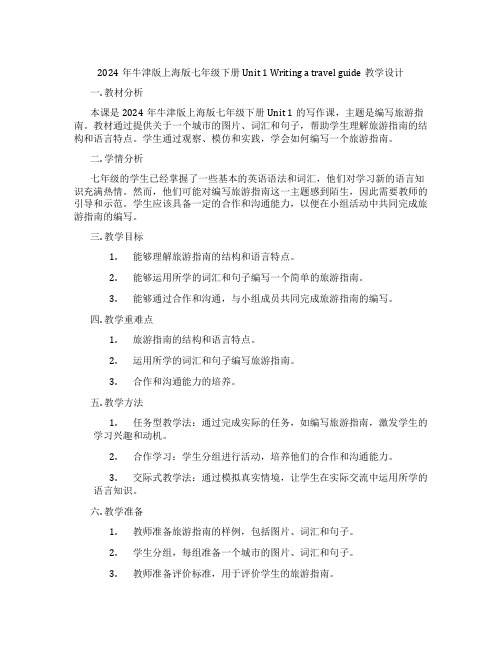
2024年牛津版上海版七年级下册 Unit 1 Writing a travel guide教学设计一. 教材分析本课是2024年牛津版上海版七年级下册Unit 1的写作课,主题是编写旅游指南。
教材通过提供关于一个城市的图片、词汇和句子,帮助学生理解旅游指南的结构和语言特点。
学生通过观察、模仿和实践,学会如何编写一个旅游指南。
二. 学情分析七年级的学生已经掌握了一些基本的英语语法和词汇,他们对学习新的语言知识充满热情。
然而,他们可能对编写旅游指南这一主题感到陌生,因此需要教师的引导和示范。
学生应该具备一定的合作和沟通能力,以便在小组活动中共同完成旅游指南的编写。
三. 教学目标1.能够理解旅游指南的结构和语言特点。
2.能够运用所学的词汇和句子编写一个简单的旅游指南。
3.能够通过合作和沟通,与小组成员共同完成旅游指南的编写。
四. 教学重难点1.旅游指南的结构和语言特点。
2.运用所学的词汇和句子编写旅游指南。
3.合作和沟通能力的培养。
五. 教学方法1.任务型教学法:通过完成实际的任务,如编写旅游指南,激发学生的学习兴趣和动机。
2.合作学习:学生分组进行活动,培养他们的合作和沟通能力。
3.交际式教学法:通过模拟真实情境,让学生在实际交流中运用所学的语言知识。
六. 教学准备1.教师准备旅游指南的样例,包括图片、词汇和句子。
2.学生分组,每组准备一个城市的图片、词汇和句子。
3.教师准备评价标准,用于评价学生的旅游指南。
七. 教学过程1.导入(5分钟)教师通过向学生展示一个旅游指南的样例,引起他们的兴趣。
引导学生思考旅游指南的作用和结构。
2.呈现(10分钟)教师向学生呈现本课的主题,展示一个城市的图片、词汇和句子。
引导学生观察和模仿,注意旅游指南的语言特点。
3.操练(10分钟)学生分组,每组选择一个城市的图片、词汇和句子。
学生在小组内共同讨论,模仿示例,编写自己的旅游指南。
4.巩固(10分钟)学生向全班展示自己小组编写的旅游指南。
- 1、下载文档前请自行甄别文档内容的完整性,平台不提供额外的编辑、内容补充、找答案等附加服务。
- 2、"仅部分预览"的文档,不可在线预览部分如存在完整性等问题,可反馈申请退款(可完整预览的文档不适用该条件!)。
- 3、如文档侵犯您的权益,请联系客服反馈,我们会尽快为您处理(人工客服工作时间:9:00-18:30)。
7B Unit 4 save the trees.
Date: ,2013
重点单词
Save 节约,节省pine n.松树discuss v.讨论,谈论Branch n.树枝,分歧root n.根,根源fight v.与···战斗Against 反对,违反example 例子harmful 有害的
gas 气体,毒气produce n.农产品oxygen n.氧气
major 主要的convenient adj.方便的furniture 家具imagine想象,想到disease n.疾病dig v.挖
Hole n. 洞carry 拿,搬运container n.容器
必背短语:
take in 吸收come from来自for example例如
in fact实际上,事实上look around四周环顾(be) made of 由··组成millions of 数以百万的(be) good for对···有害
仔细讲解:
1.If I plant this seed in the ground,will it become a pear tree,Hi?(page43)
由if 引导的条件状语从句,表示”如果”,
①如果主句(包括祈使句、含有情态动词can、may、must)用一般现在时,从句也要
用一般现在时;
②主句用过去时,从句也要用过去的某种时态,如果主句是一般将来时态,从句要用
一般现在时表示将来。
2.They help fight against pollution.(page44)
Fight vi. 与….斗争,常与介词against或with连用。
如:They fought against the enemy fiercely
扩展:fight vt.战斗,反对,可直接跟宾语。
如:They fought their enemies bravely. 他们勇敢杀敌
扩展:against prep. 意为“,违背,违抗;紧靠,防备”
如:We take out umbrella just against a rainy day.我们带上雨伞以防雨天。
4.A lot of the furniture is made of wood.(page45)
①Furniture 不可数名词,家具。
My piano is made in Beijing. The birthday cake is made by my mother. The table is made of wood. Wine is made from grapes. Grapes are made into wine.
The bike is made in China. (记忆顺口溜:物质不变用of ,物质变化是from )
7.She can skate at a very high speed because she practises a lot.
①Practise vt. 训练,练习。
宾语可接名词,代词,动名词。
如:It's very important to practise listening. 练习听力是非常重要的。
②Practise vi. 如:Don' t forget to practise after class. 课后别忘了练习。
③practise 的名词是 practice 不可数名词。
通常指经常性或系统性的重复练习。
Practice makes perfect. 是一句谚语,意思是“熟能生巧”。
8.But the speaker did not stop speaking until twenty past twelve.(page52)
Not …..until 意为:直到…..才…..。
主语的动词一般为非延续性动词,它所表示的动作 直到 until 所表示的时间才发生。
如:We won ’t see any flowers until May.
Unitil 连词,意为:直到…..时。
用于肯定句,主句的动词一般为延续性动词。
如:He waits the children are asleep. I shall stay here until twelve o ’clock.
11.It covers five and a half million square kilometers of the Amazon Basin and spreads across nine countries.(page54)
(1)①Cover v. 覆盖,遮盖;
cove…with 用···把··盖上;be covered with…被….覆盖着。
如:The road is usually covered with snow in winter
②Cover 可数名词,意为:覆盖物,盖子,封面
如:The new book needs a new cover.
12.Many living things lose their homes because of deforestation.(page54)
13.As a result, the number of kinds of animals, birds, insects and trees in the world is
14.Tea is the most popular drink in the world besides water.(page55)
茶是世界上除了水之外最受欢迎的饮料。
语法:现在进行时
一、教材经典句子:
1.The children are playing in the park。
2.We are staying at Peter’s house at the moment。
二、现在进行时:一般表示此刻正在进行的动作,也表示目前阶段一直进行的动作。
三、用法:
1.现在进行时一般表示此刻正在进行的动作,常和now,right now,at this moment等
时间状语连用,以及动词look,listen等。
如:Look!She is cleaning my room now。
2现在进行时表示目前阶段一直进行的动作,但是说话时不一定正在发生,常和“these days,this week,at present”等连用。
如:Is Jame working hard this term?
注意:
1.一些表示状态和意愿的动词,如be,like,want,kown,think,have等,
不能用于现在进行时态。
如:I want to go home now。
e,go,leave,stay,start,arrive等表示往返或位置转移的动词,可以用现在进行时表示将要发生的动作,这些动词可以与“tomorrow,next week”等表示将来的时间状语连用。
3.现在进行时与always,often等词连用,也可表示习惯的、经常重复的动作。
意为总是,老师。
此时常常有埋怨、赞赏的色彩。
如:Mary is always talking about her son.
四、结构:
1.肯定句:主语+be(am,is,are)+现在分词+其他如:He is doing his homework .
2.否定句:主语+be(am,is,are)+not+现在分词+其他如:he isn’t writing now?
3.一般疑问句:be(am,is,are)+主语+现在分词+其他?
如:Are you singing ?——yes ,I am.
4.特殊疑问句:疑问词+be(am,is,are)+主语+现在分词+其他?
-What are you doing? -I am doing my homework.
五、现在分词的构成:
(1)一般情况下,直接加ing,如:cook-cooking
(2)以不发音的e结尾,去e加ing,如:make-making, taste-tasting
(3)如果末尾是一个元音字母和一个辅音字母,双写末尾的辅音字母,再加ing,如:run-running, stop-stopping sit-sitting
get-getting run-running forget-forgetting begin-beginning
(4)以ie结尾的动词,改ie为y加ing ,die--dying lie--lying。
